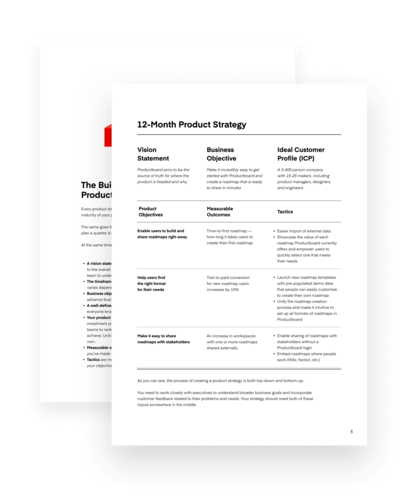Introducing Productboard Pulse. Exec-level insights into what your customers need, powered by AI.
Learn more

Being a good product manager means championing the voice of the customer while advancing broader business goals. At the same time, you have limited resources and can’t do everything at once. That’s where product strategy comes in.
This template aims to make the product strategy process feel a bit more tangible. It is paired with a sample product strategy from Productboard. The example focuses on actionable, customer-centric problem solving rather than simply listing problems or solutions at face value.
Get your copy and up-level your product strategy process today!

”Before there was no unified way of planning or prioritizing. Productboard has majorly improved how we collaborate to develop great new features.”
Martin Svoboda
Senior Product Manager at Avast

”Productboard helped us provide stakeholders visibility into our journey through a critical transformation of our product portfolio.”
Brian Trzupek
SVP Product Management at DigiCert

”Productboard helps product managers figure out what to build next… and why.”
TechCrunch
from TC Disrupt Competition

”Great product! Beats the heck out of our old system of spreadsheets, my inbox, and a Trello board.”
Bradley Wagner
VP Engineering at hannonhill

”Productboard is a no-brainer for every serious product manager. You'll wonder how you got by without it.”
Chase Lee
Co-founder & CTO at ambassador

”Productboard is a member of our team we can't live without.”
Wells Riley
Product and Design at Envoy

”After I showed the team how Productboard could align product with sales, development, and marketing, everybody was just thinking "finally!"”
Tim Clauwaert
CEO & Co-Founder at intuo

”I haven't fallen in love with a product like this in a very long time!”
Jewel Loree
Senior Product Manager at Headset

”I've tried a few PM tools, and Productboard is the only one that captures the essence of what product management is about — and does so in style.”
Nicolay Alexiev
Product Operations Lead at Airtasker

”We funnel all our company's user insights through Productboard. It's changed my life.”
Cam Hilsman
Senior Product Manager at SalesLoft

”I don’t often feel like I'm using "the next big thing” but that’s how I feel about Productboard.”
Tyler Mills
Product Manager at Zaius
